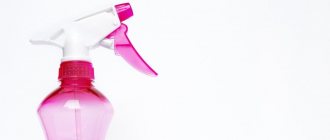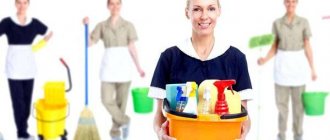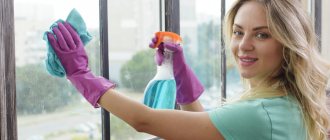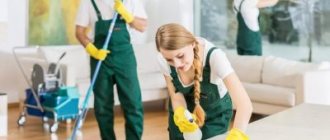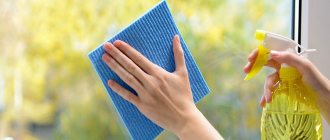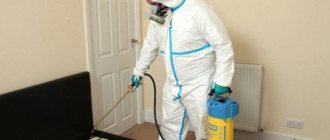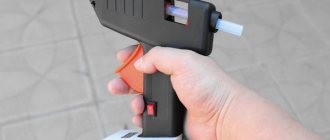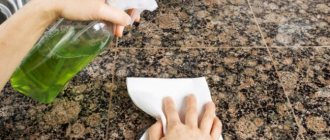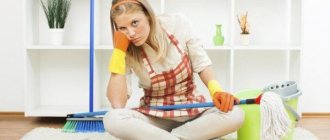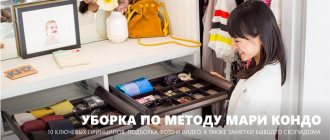Excerpts from SanPiN 1079-01
For cleaning production, warehouse, auxiliary premises, as well as toilets, separate equipment is allocated, which is stored in specially designated areas, as close as possible to the cleaning areas. Toilet cleaning equipment is marked with a signal color and is stored separately.
Special personnel are assigned to clean toilets.
Cleaners must be provided with sufficient cleaning equipment, rags, detergents and disinfectants.
Excerpts from SanPiN 2821-10
Toilets, dining rooms, lobbies, and recreation areas are subject to wet cleaning after each break.
Daily cleaning of toilets, showers, buffets, and medical premises is carried out using disinfectants, regardless of the epidemiological situation. Sanitary equipment must be disinfected daily. Handles of flush tanks and door handles are washed with warm water and soap. Sinks, toilets, toilet seats are cleaned with brushes or brushes, cleaning agents and disinfectants permitted in accordance with the established procedure.
Cleaning equipment for cleaning sanitary facilities (buckets, basins, mops, rags) must have a signal marking (red), be used for its intended purpose and stored separately from other cleaning equipment.
Excerpts from GOST R 51870—2014
3.2 Toilets, showers, sanitary inspection rooms
3.2.1 Daily:
— wet floor cleaning;
— washing and disinfection of all sinks, toilets, etc., both inside and outside;
— washing seats on both sides; — emptying and cleaning (if necessary) containers for collecting paper, removing waste to specially designated areas;
— cleaning and polishing of mirrors and metal surfaces; — complete with paper towels, soap, toilet paper;
— removing stains from walls, partitions, doors and external surfaces of all containers; — cleaning of all pipes and shut-off valves;
— removing soap and water stains from wall surfaces near soap containers, sinks, toilets, etc.;
- wet wipe of drainage grates
Inventory
Storage of equipment There are requirements for equipment and detergents that can be used during cleaning.
They must be safe and effective. And the employee must have a uniform. Rules for the selection and storage of equipment and disinfectants:
- cleaning equipment should not be stored in the school toilet, but in a special storage room;
- containers and other accessories should be marked in different colors depending on the room for which they are used;
- buckets must be signed so as not to be confused;
- It is allowed to use only equipment that is subject to disinfection;
- after each use, rags, rags and other devices are disinfected;
- chloramine solution, Samarovka, Clorosept are used as disinfectants. Devices are treated in each disinfectant liquid for at least an hour;
- Rags for floors and walls in the toilet room should be separate.
You cannot wash the gym and the bathroom with the same rags, or use the same equipment. It is recommended to have a separate disinfectant solution.
Before cleaning, the employee must prepare. The work uses gloves, an apron, and a long-sleeved uniform. Disinfectants should not damage the skin. It is not recommended to hire people with sensitive skin.
Important! To ensure proper order in the school, you need to have an industrial vacuum cleaner.
Services and their cost
The cost of cleaning in a kindergarten depends on the prices of the selected cleaning company, the volume and type of work to be done.
Approximate prices:
- Area less than 100 m2: daily - 5500 rubles, general - 7500 rubles.
- Area 250 m2: daily – 7500 rubles, general – 12500 rubles.
- Area more than 300 m2: daily - from 35 rubles per square meter, general - from 70 rubles per square meter.
Daily cleaning in the group includes the following types of work:
- wiping dust from all surfaces, including mirrors and glass;
- cleaning carpets with a vacuum cleaner;
- washing window sills and baseboards;
- floor cleaning;
- making beds;
- taking out the trash.
If the cleaning is general, then the following types of work are added to the listed items:
- Vacuuming upholstered furniture.
- Washing all lighting elements.
- Moving furniture aside and washing the floor behind it.
- Washing heating appliances.
- Cleaning inside cabinets, dusting shelves.
- Cleaning radiators with a steam generator.
You will have to pay separately for cleaning after the repair. The price starts from 13,500 rubles per 200 m2. This treatment involves eliminating all visible consequences of the repair, for example, removing grout, traces of paint, plaster, etc.
Before entrusting the processing of the preschool territory to a cleaning company, you need to clarify with what detergents they will use to carry out the task.
All disinfectant compositions must meet safety requirements and not pose a threat to the health of children. Workers performing cleaning in preschool educational institutions are required to have valid sanitary certificates.
Everything you need to know about cleaning the area can be found in this section.
Toilet Cleaning Schedule: Sample
If we paraphrase the well-known saying about the toilet, which is supposedly the face of the housewife, then the cleanliness and order of the toilet in a public institution is an image indicator of the company.
The bathroom cleaning schedule significantly simplifies the procedure and also complies with the requirements of SanPiN.
Depending on which organization the toilet room is located in, how much traffic there is and some other factors, the schedule indicates the required frequency of cleaning and the time it takes to complete it.
Deep cleaning of restrooms at different sites varies from once a month to a weekly process.
For the convenience of performers and controllers, it makes sense to include the following items in the schedule:
- Time. A “from” and “to” limiter is indicated here so that the room is not closed for too long. In case of general cleaning, a specific date is indicated.
- Executor. A box for your full name and signature, so that in case of complaints (preferably, of course, thanks) there is someone to present them to.
- Controller. A box for the full name and signature of the person who conducted the inspection. (It’s immediately clear that the organization or company is serious - even something like the condition of the toilets is under control!).
Controller - a person whose responsibilities include monitoring the quality of cleaning in the toilet,
Registration requirements
The document is drawn up in accordance with sanitary and epidemiological rules and regulations (SanPiN) for organizations and contains the following information:
- Current date.
- Cleaning time.
- Full name of the responsible executor.
- Information about the controller.
The schedule is posted on the wall. After each cleaning and inspection, the personal signatures of the responsible and inspecting person are placed in the fields specially designated for this. The completed document is stored in the archive for a period established by the organization, after which it is disposed of.
In terms of timing, the schedule can be drawn up for:
- day,
- month,
- quarter,
- half a year or a year.
To create the necessary document, you can use a ready-made sample, an online designer, or seek help from professionals.
Why is there no universal document? Cleaning of bathrooms in different institutions can vary significantly:
- quantity,
- frequency,
- duration of treatments,
- requirements for disinfectant solutions and their preparation time.
Proper Restroom Cleaning Schedule: Sample Form
Standards for cleaning office premises
Since the toilet in any enterprise is one of the most frequently visited places. That is why it is imperative to keep it clean and tidy.
To avoid controversial situations, it is imperative to draw up a special schedule for registering toilet cleaning.
What needs to be noted in such a document? Key points on the form include:
- list of responsibilities of the cleaner;
- date of the cleaning procedure;
- its exact time.
Also, such a form must include the full name of the person who is responsible for sanitizing the restroom.
Competent and constant maintenance of this kind of documentation allows you to not only maintain the toilet at the site in order.
The schedule and its adherence ensure that those responsible for cleaning are identified and their work is accounted for.
Catering enterprises
Since we are talking about the health of visitors, supervisory authorities require strict compliance with the rules from owners of cafes, restaurants and canteens. The cleanliness of the bathroom is considered an indicator of the overall sanitary and hygienic level.
It is necessary to carry out daily disinfection , and treat plumbing fixtures with hydrochloric acid every three days. Daily, periodic and general cleaning schedules are drawn up.
Large catering establishments prefer to contact cleaning companies to improve the quality of cleaning and comply with all regulatory requirements.
School cleaning
Work plan schedule in excel
High school students are often outraged when they have to clean the classroom. The question is not as simple as it seems at first glance. On the one hand, self-care and basic work skills should be the norm in school life. On the other hand, there are fewer and fewer people willing to work as nannies and cleaners. Who should clean the classroom anyway? How often should a school be wet cleaned? These and other issues that concern parents of students and students themselves are regulated by SanPiN 2.4.2.2821-10 “Sanitary and epidemiological requirements for the conditions and organization of education in general education institutions.”
All premises of educational institutions are subject to daily wet cleaning using detergents, and in schools operating in two shifts - twice a day. To carry out wet cleaning of premises and to ventilate them, a break of at least 30 minutes is provided; in case of an unfavorable epidemiological situation, the break is increased to 60 minutes for disinfection treatment.
To carry out cleaning and disinfection in general education organizations and boarding schools at general education organizations, they use detergents and disinfectants that are approved in accordance with the established procedure for use in children's institutions, following the instructions for their use.
Toilets, dining rooms, lobbies, and recreation areas are subject to wet cleaning after each break. Cleaning of educational and auxiliary premises is carried out after the end of lessons, in the absence of students, with windows or transoms open. If a general education organization works in two shifts, cleaning is carried out at the end of each shift: floors are washed, dust accumulation areas are wiped (window sills, radiators, etc.).
Cleaning of lighting fixtures is carried out as they become dirty, but at least 2 times a year. Exhaust ventilation grilles are cleaned of dust monthly. The premises of a boarding school at a general education organization are cleaned at least once a day.
At least once a month, general cleaning must be carried out in all types of premises of a general education organization and boarding school at a general education organization. Moreover, it must be carried out using not only detergents, but also disinfectants, so it is not allowed to involve children in such cleaning.
It is also not allowed to involve students in work with harmful or dangerous working conditions, during which the employment of persons under 18 years of age is prohibited, as well as in cleaning sanitary facilities and common areas, cleaning catering facilities, washing windows and lamps, removing snow from roofs and other similar works.
Cleaning equipment for cleaning premises must be labeled and assigned to specific premises. Cleaning equipment for cleaning sanitary facilities (buckets, basins, mops, rags) must have a signal marking (red), be used for its intended purpose and stored separately from other cleaning equipment.
At the end of cleaning, all cleaning equipment is washed with detergents, rinsed with running water and dried. Cleaning equipment is stored in a place designated for this purpose. Disinfectants and detergents must be stored in accordance with the instructions and out of reach of students. Disinfectant solutions are prepared for cleaning floors immediately before use in restrooms and in the absence of students.
In order to prevent the spread of infection in the event of an unfavorable epidemiological situation, additional anti-epidemic measures are carried out in educational institutions according to the instructions of the bodies authorized to carry out state sanitary and epidemiological surveillance.
Source
Established standards
Toiletries must be replenished every time after cleaning.
Toilets must be wet cleaned daily. But there is a technological map that accurately indicates the frequency of processing of different surfaces. The cleaner must comply with established rules and regulations.
Two rules to apply when cleaning:
- Brush brushes should have replaceable bristles. It is changed 4 times a year. Or once every 3 months. Can be done more often as needed. It is recommended to choose black brushes;
- Cleaning is not limited to cleaning surfaces. Every time after work you need to replenish toilet paper, towels, soap and other supplies.
How often to disinfect:
- mirrors are cleaned daily;
- The walls are washed 1 meter high every day. Once a month they clean all the way to the ceiling;
- sanitary equipment is disinfected constantly, every day;
- door handles and blocks are disinfected every time after continuous cleaning;
- Clean the ventilation grilles every 3 months;
- Wet cleaning and trash removal are carried out daily.
The documents contain rules that explain how many times a week you need to clean each part of the bathroom. The nuances that every employee of an educational institution needs to know are also indicated.
What information should be in the journal
There is no unified form for recording current cleaning. Its form and sample schedule for cleaning premises during coronavirus are sometimes established by order of the health department of a particular region. If a mandatory form has not been introduced in a subject, organizations have the right to develop it independently or use ready-made forms of any convenient sample. There are also special programs that help in drawing up such documents.
It is generally accepted to maintain a document in the form of a table. In its sequentially numbered columns enter:
- name of the premises;
- date and time as planned;
- name of the cleaning products used;
- actual date and time of the cleaning event;
- Full name of the performer with his signature.
Information is entered immediately upon completion of the work.
The contents of the table items, date, time and frequency must comply with the sanitary standards established by law for this type of premises.
The contents of the general cleaning log are regulated by SanPiN for certain areas of activity: SanPiN 2.1.3.2630-10 for medical institutions, SanPiN 2.4.2.2821-10 for educational institutions, SanPiN 2.1.2.2631-10 for hairdressing salons, etc.
It includes:
- serial number;
- planned date;
- the disinfectant used and its concentration;
- actual date of the event;
- Full name and signature of the performer.
There is no generally accepted sample for a disinfection log; a sample schedule for disinfection of premises during coronavirus cannot be downloaded from the Rospotrebnadzor website, either, because it does not exist. There are only a number of methodological recommendations, both general and for individual areas of activity, that must be taken into account when compiling it. It is maintained in free form (electronic or paper). Many people use the form introduced by the Committee for Culture of the City of Moscow on September 10, 2001 for institutions subordinate to it; it is called “Book of accounting for the receipt, consumption of disinfectants and disinfection work at the facility” and was developed taking into account all the requirements of the SES and Rospotrebnadzor.
The disinfection log includes:
- information about the company (name, type of activity, address);
- responsible for the availability of disinfectants and disinfection;
- calculation of the need for disinfectants;
- disinfection schedule;
- accounting of incoming disinfectants (indicating the invoice number);
- room and its area;
- data on actual disinfection work carried out;
- disinfectants used, their quantity and concentration;
- signature of the employee who carried out the disinfection.
Kindergarten menu for 14 days.
The nutrition of children is approved by the head of the preschool institution. The document is a menu designed for 14 days.
In addition, when compiling this list, national preferences and the peculiarities of the territorial representation of cuisine, as well as the health of minors, are taken into account.
Drawing up an assortment of dishes requires a clear distribution of calorie content within the day.
Thus, separate meals must be planned taking into account its energy value.
More detailed information about the diet in kindergarten is given in the summary table below.
| Preschool visit form | Time | Approximate caloric value, % |
| Constant | breakfast | 20 |
| 2nd breakfast | 5 | |
| dinner | 30 | |
| afternoon tea | 15 | |
| dinner | 25 | |
| before bedtime | 5 | |
| 10 o'clock | breakfast | 25 |
| 2 breakfast | 5 | |
| dinner | 35 | |
| afternoon tea | 15 | |
| 12 o'clock | breakfast | 25 |
| lunch | 5 | |
| dinner | 35 | |
| afternoon tea | 15 | |
| dinner | 20 |
If children stay in a preschool educational institution for twelve hours, afternoon snacks and dinner can be replaced with a compacted afternoon snack with an energy value of 30-35 percent of the daily value.
The decision is made by the kindergarten administration taking into account the current situation.
Treatment of premises during coronavirus at the enterprise
If employees have not been transferred to remote work, then they simply need to ensure maximum safety.
The cleaning of premises against coronavirus is the responsibility of cleaners of industrial premises. They maintain cleanliness and order in accordance with the requirements of the employer. To do this, they use different tools, equipment, and chemicals that help clean the premises and disinfect and disinfect them.
Particular attention is paid to public places: toilets, gyms, eating areas and rest rooms. Disinfection in such rooms should be carried out every two hours.
Cleaners thoroughly wipe down walls, floors, work surfaces, door handles, tables and chairs, and all equipment using disinfectants. Then the premises must be ventilated for 15-20 minutes. This regime helps prevent the spread of coronavirus and ensure safety for all workers
Disinfection in such rooms must be carried out every two hours. Cleaners thoroughly wipe down walls, floors, work surfaces, door handles, tables and chairs, and all equipment using disinfectants. Then the premises must be ventilated for 15-20 minutes. This regime helps prevent the spread of coronavirus and ensure safety for all workers.
Disinfection of office premises should be carried out twice a day. But if infected people are identified at work or those who have previously been in contact with sick people, cleaning is carried out every two hours.
Do I need to create a schedule for sanitizing surfaces during Covid?
To prevent the spread of coronavirus within the organization, a special schedule is drawn up for treating surfaces in office premises. This is an important document to follow. It allows you to maximally protect employees at the enterprise and prevent the spread of the virus.
After all, employee safety is the most important criterion during the Covid pandemic.
Compilation rules
A schedule for sanitizing surfaces is drawn up in any form. This document is necessary for employees who are responsible for carrying out these events.
A schedule is drawn up on an A4 sheet, which indicates the initials and position of the responsible person, as well as the name of the premises.
There must also be a signature of the person who carries out this processing and the signature of the person who monitored all these activities. This schedule allows the cleaner to know when to clean the area next.
The disinfectants used are safe for employees. Therefore, sanitary treatment of surfaces can be carried out in the presence of personnel. This is very convenient, because specialists can not stop working while carrying out these preventive measures.
The results of the sanitation carried out are recorded in a special journal for recording surface treatment for Covid-19.
SanPin for kindergartens with changes in 2022
Children are admitted to kindergarten personally by a teacher or a medical professional. This need is associated with preventing the admission to classes of children with any infectious or contagious diseases. If a kindergarten worker suspects an improper health condition, the child is not allowed to study.
As for the organization of the educational process and rest regime, most of the standards are advisory in nature. The main ones include:
- the continuous period of activity should not exceed 6 hours in groups with children over three years old;
- It is advisable that walks in the fresh air take three to four hours daily;
- It is not recommended to take children outside when the temperature is less than 15 degrees;
- It is advisable to divide the time of street walks into two periods;
- depending on the length of the children’s stay in kindergarten, the number of meals and the availability of daytime rest are recorded;
- The duration of lunchtime sleep varies between 2-3 hours, depending on the age of the student.
Control over the formation of comfortable conditions for the rest and development of children falls on the shoulders of educators, who must monitor the proper cleaning and preparation of playrooms and bedrooms for the reception of children. So, in addition to observing the temperature regime, it is necessary to control the air humidity and ventilation of the premises.
According to SanPin, all rooms in which children play, study or relax must be ventilated. And the procedure is carried out according to the following standards:
- at least twice a day for a maximum of 30 minutes with the formation of a draft, but in the absence of children;
- ends half an hour before the students arrive;
- unilaterally in the presence of children and only in hot, dry weather.
According to SanPin, air humidity in kindergarten rooms in 2022 should not rise above 60% and cannot be below 40. As for temperature, the following limit values are allowed:
- gaming within 21-24, the most optimal is 24 degrees;
- the bedroom ranges from 18-22, but 22 is best.
Kindergarten is the first step towards the comprehensive development of a child, so it is very important to organize the right approach to raising children. Thus, according to the established SanPin rules in 2021, the daily routine in a preschool educational institution should contain the following activities:
- exercises in the group room (should be carried out at least twice and the duration of the exercises depends on the age of the kids and should vary between 5-15 minutes);
- physical activity in the fresh air (which also includes active sports games);
- role-playing games in groups that require active participation;
- swimming (if the kindergarten has swimming pools);
- training sessions (the duration of one block of developmental sessions should not exceed ten minutes and should be replaced by other types of activities);
- physical education (includes several simple exercises).
As for training lessons, they include:
- familiarity with numbers and letters;
- art classes;
- music and choreography;
- modeling from plasticine;
- making crafts from natural materials;
- development of logic and memory.
The teacher is required to be able to correctly distribute all types of employment in order to equally pay attention to all types of activities. Maintaining order in groups is one of the main areas monitored by the sanitary and epidemiological service in kindergartens in 2021, especially during the period of widespread spread of various infections
So, a soap-soda solution is used as a detergent if additional disinfection is necessary. The use of detergents is allowed, but only those that are not harmful to health
Maintaining order in groups is one of the main areas monitored by the sanitary and epidemiological service in kindergartens in 2021, especially during the period of widespread spread of various infections. So, a soap-soda solution is used as a detergent if additional disinfection is necessary. The use of detergents is allowed, but only those that are not harmful to health.
Most often, baby soap is used to clean and wash toys. It applies:
- for washing floors;
- when cleaning door handles, tables and chairs;
- while washing windows;
- in cases of washing clothes and toys.
In addition, air and power vacuum cleaners are used to clean carpets, mattresses and pillows.
How often and what to wash in the office
Disinfection of office premises is:
- a preventive measure not only against coronavirus, but also during epidemics of influenza and ARVI;
- a complete method of getting rid of pathogenic viruses and bacteria.
According to the recommendations of Rospotrebnadzor, employers disinfect and clean office premises to prevent the spread of coronavirus infection. The requirements are established in letters from the department. They are different for organizations that are operating and have temporarily suspended their activities (or whose employees have switched to remote work). The latter carried out disinfection before closing offices and switching to self-isolation.
Not only operating organizations are recommended to carry out processing, but also those that have temporarily suspended their activities. Recommendations from Rospotrebnadzor on how to disinfect an office where work has been suspended or employees have been transferred to remote work:
- on your own or with the involvement of specialists and cleaning companies;
- periodic treatment of frequently used surfaces with disinfectants;
- use of certified products based on chloroactive and oxygen-active compounds, cationic surfactants;
- preliminary preparation of solutions in accordance with the instructions;
- the use of wiping and irrigation methods for horizontal and vertical surfaces, the processing of tools and utensils is carried out by immersion;
- periodic ventilation of premises;
- carry out work with gloves;
- comply with safety requirements.
The approved instructions for disinfecting office premises against coronavirus are annex to the letter of the Federal Service for Surveillance on Consumer Rights Protection and Human Welfare dated March 27, 2020 No. 02/5210-2020-24.
NPA
Letter of Rospotrebnadzor dated March 27, 2020 No. 02/5210-2020-24 “On carrying out disinfection measures in office premises” The letter contains instructions on the procedure for carrying out disinfection measures in order to prevent a new coronavirus infection in the office premises of organizations that have temporarily suspended operations or whose employees have transferred for remote work. Letter of Rospotrebnadzor dated March 10, 2020 No. 02/3853-2020-27 “On measures to prevent the new coronavirus infection (COVID-19)” (together with “Recommendations for the prevention of the new coronavirus infection (COVID-19) among workers”) High-quality cleaning is recommended premises using virucidal disinfectants, special attention is paid to the disinfection of door handles, switches, handrails, railings, contact surfaces (worker tables and chairs, office equipment), common areas (eating rooms, rest rooms, toilet rooms, rooms and equipment for classes sports, etc.), in all rooms with a frequency of treatment - every 2 hours. Please note that regular and frequent disinfection of organizations is not a prescribed measure, but a recommended one
Let's list why they should be followed if your office is open during a pandemic:
Please note that regular and frequent disinfection of organizations is not a prescribed measure, but a recommended one. Let's list why they should be followed if your office is open during a pandemic:
- it's about people's safety;
- COVID-19 is transmitted by airborne droplets (main route);
- the spread of infection as a result of the actions or inaction of organizations and officials is punishable by large fines.
Occupational Safety and Health
If possible, preserve the situation in which the accident occurred, if this does not threaten the life and health of others and does not disrupt the technological process, in order to investigate the causes of the accident, or record it in a photo or video.
Notify management and occupational safety specialist.48. In the event of an injury, the employee must stop work,, if possible, provide first aid to himself and notify his immediate supervisor or ask others to do this.49.
How should you clean the bathroom?
Keeping the “heart” of the room clean increases the value of the property and reduces the cost of replacing or repairing plumbing fixtures, as well as tiles and paint.
Regular cleaning is a must, but often a few things get overlooked. Preparing a cleaning checklist and performing cleaning activities in accordance with it will ensure that every inch of the room is cleaned.
All you need to do is check its execution.
Stages of cleaning a bathroom:
- Clean the bathtub. Apply the cleaner to the walls, scraping stains in a circular motion from top to bottom. Rinse the walls with water to remove the cleaner and wipe with a damp cloth. Wipe mirrors and glass surfaces. Rub until shiny.
- Treat your shower to prevent mold growth. Clean the shower area. Wipe down the rods, towel rings, and shower. Use a cleaner.
- Wash the sinks. Wash the sink with a sponge or damp cloth using a cleaning product, you can use vinegar for a deep clean. Wipe down faucets and fixtures, toothbrush holder, and soap dispenser. Fill the soap dispenser.
- Disinfect the toilet. Pour in disinfectant liquid, wait 15-20 minutes, and use a toilet brush to clean off all stains. Wipe with a sponge inside as well as outside.
- Empty the trash can. Spray the inside and outside of the trash can with all-purpose cleaner and wipe it with a rag.
- Clean the exhaust fan vents.
- Put it away in your first aid kit. Take out the contents of the medicine cabinet, place it in the sink, then wash the walls and shelves. Scrape off any dirty spots.
- Clean out the cabinets. Lightly dampen the cloth with water and cleaner and clean the cabinets and drawers.
- Remove dust. Wipe dust from lamps and switches. Wash and clean window panels, tracks, ledges.
- Replenish toilet paper if needed.
- Wash the floor. Starting at the farthest corner of the room, work the mop toward the door, alternating between left and right. Wash the floors a second time using clean water, without cleaner.
Check everything on the list and get a sparkling clean room!
This 11-step guide can thoroughly clean the dirtiest room in just a few hours. Remember: a bathroom cleaning schedule is the key to cleaning success.
If you liked our material, share it with your friends on social networks or just send them a link. A complete checklist for cleaning indoor bathrooms will be useful to your colleagues.
Read other articles on the Guardian of Purity portal. Stay with us!
Bathroom general cleaning schedule
You can determine your own schedule for general cleaning. For some, it will be enough to carry out all the procedures once every 3 months, but for others, even once a month will not be enough. It all depends on how often the bathtub is used in your home.
During general cleaning, the following operations should be carried out:
- First, remove the curtain and soak it in a soap or powder solution. This will remove smudges and stagnant stains from it.
- All bottles and various hygiene products must be removed from the bathroom. The easiest way is to use a basin for this.
- If there is a rug in the bathroom, it is also worth soaking and washing it. If it is clean, take it out of the bathroom along with the bottles.
- On the surface of the bathroom and sink, apply a detergent intended for the surfaces from which these containers are made and leave everything for the time specified in the instructions for the detergent. The same operation should be done with the toilet, only separate detergents should be used for the inner and outer surfaces.
- Thoroughly wash all mirror and glass surfaces, including shelves.
- Using an old brush (sponge, washcloth), remove any remaining detergent from the surface of the sink and bathtub, and rinse it with cold water.
- Next, use a brush to clean the inside surface of the toilet and flush the water. The outer part is wiped dry with rags or sponges.
- Now you can start cleaning the floor. This must be done using special disinfectants.
- After all these procedures, you can put all hygiene items in their places, and also hang the curtain and rug in place.
Helpful Tips and Tricks
- If rust stains appear on the surface of the bathtub, you need to use vinegar to wash them off, and if there is limescale deposits, you can add a little vinegar to the detergent (or buy Pemoxol).
- Sometimes a yellowish coating may occur. You can use chlorine bleach to remove it, but you need to rinse it off thoroughly at the end.
- When cleaning a bathtub or sink, do not use metal brushes.
- You can achieve a pleasant smell in the bathroom with the help of orange. Hang it in your room and stick in some toothpicks or nails.
- Microfiber can be used to clean glass and mirror surfaces. This material is able to remove a wide variety of contaminants without the use of special detergents.
- To make your faucets sparkle, you can treat them with a solution of vinegar and salt.
- When cleaning tiles, it is very convenient to use detergents in the form of an aerosol.
Caring for the bathroom in words looks quite troublesome, but even general cleaning, if you have all the means and follow the appropriate regime, will not take more than an hour.
Equipment and detergents, a set of workwear
According to sanitary standards, a room of this type must be cleaned in special clothing designed for this purpose. Following the rules will avoid contact with germs. The use of casual or formal clothing is also excluded, as detergents can get on the fabric and ruin it. At home, it is worth highlighting a special form of convenient things used specifically for cleaning.
Availability is important:
- brush;
- cleaning gloves;
- rags;
- sponges;
- brushes;
- mops;
- buckets.
You also need to purchase in advance all the necessary tools that will help you quickly complete the task. Be sure to have glass spray. It is better to choose a proven product that does not leave streaks. You also need a gel for cleaning the toilet and other plumbing items. They usually have a composition that does an excellent job of killing bacteria. In addition, they must cope with limescale and rust, which will improve the appearance of the plumbing.
We recommend:
Rating of robot vacuum cleaners: features of choosing models for the home
Instructions for cleaning bathrooms
Aseptic procedure for cleaning the toilet Cleaning the toilet should be carried out according to the established algorithm. This helps to achieve maximum cleanliness in the room. The process is described and approved in detail.
Instructions for cleaning the toilet at school:
- Prepare cleaning supplies and necessary equipment.
- Disinfect your hands and prepare your clothes.
- Put up a sign warning about wet fields.
- Turn on the light and empty the trash bin. Drain the water from the barrel. Remove water from the toilet using a brush. Check that the unit is not clogged.
- Apply disinfectant to edges and rim. Leave for a while.
- Wipe surfaces with a dampened cloth, including mirrors, soap dishes, and dispensers.
- Clean the walls from dirt at least 1 meter from the floor.
- Wipe down switches and door handles.
- Wash the sink, faucet and other parts.
- Wipe the tank, toilet seat, and outer surface with a disinfectant. Repeat with a dry cloth.
- Pour the disinfectant into the brush container and place it there.
- Clean the trash container.
- Ventilate the room.
- Treat the door handle when exiting.
- Disinfect equipment that was used and dry it.
- Wash the hands.
Important! If the disinfectant must be washed off, the cleaner must additionally treat the surfaces with a clean napkin
At school or kindergarten, you need to keep the premises clean
It is important to pay special attention to bathrooms. There is a risk of infection in this place, as in a clinic or other medical facility
What it is
What SanPin regulates
In order to create optimal conditions and comfort for students and school employees, it is necessary to control the safety and cleanliness of the premises. Therefore, there are established norms and rules that need to be followed.
SanPin for schools is a document that regulates the operation of educational institutions. Helps make training and its mode safe for its participants. Hygienic requirements for maintaining cleanliness change periodically. The regulatory document contains requirements for the location of the building, the selection of equipment, and equipment. The standards for air-thermal conditions, lighting sources, and the organization of medical care are described. Hygiene requirements specify how to ensure cleanliness in different types of premises. You can find a set of information about how often bathrooms are cleaned at school, according to the requirements.
According to the established schedule, bathrooms in schools and kindergartens are cleaned according to SanPin. This is a place of increased risk of spreading infection. He should get a lot of attention. The document contains information on how to disinfect surfaces.
When establishing the schedule and rules for cleaning and disinfecting premises in schools, SanPin requirements must be used. According to them, cleaning products and equipment are selected that will be used to clean the toilet.
Instructions for routine cleaning of the bathroom
Instructions for routine cleaning of the bathroom
Routine wet cleaning of toilets using disinfectants according to an antibacterial regime should be carried out twice a day, maintenance cleaning - when dirty, as needed.
Once a month, carry out general cleaning using a disinfectant in antibacterial mode.
For routine general cleaning of toilets, allocate two separate sets of cleaning equipment. Buckets, containers for washing walls, mops, mops, napkins, sponges and other items must be clearly marked (or color-coded) indicating the types of cleaning work and used strictly for their intended purpose. It is prohibited to use hair brushes and brooms for cleaning.
When carrying out work, change the cleaning material and working solutions of washing disinfectants if they become visible. All cleaning equipment should be disinfected, washed and dried after cleaning. Cleaning equipment should be stored in sanitary rooms in separate marked sections.
Be sure to wash your hands before and after cleaning. Upon completion of cleaning, additionally treat your hands with a skin antiseptic.
Cleaning equipment and workwear
A set of workwear (robe, rubber gloves, mask). Container for cleaning disinfectant solution for surface treatment. Rags (napkins) for surface treatment: separately for applying the disinfectant and for washing it off (if required), as well as for drying and polishing. Bucket, mop, rags for cleaning the floor. Container and brush for cleaning the toilet. Plastic bags for collecting used rags. Washing disinfectant solutions for surface treatment.
Current cleaning technology
Turn on the lights, check the toilet, remove the trash bags from the baskets and place them in a Class B waste container. Close the toilet lid, flush the water. Open the lid and use a brush to lower the water level in the toilet, pushing it down. Apply a disinfectant detergent to the edges of the toilet bowl and its rim. Close the lid and leave for the duration of the exposure.
Use a damp cloth moistened with a cleaning disinfectant solution from a surface treatment container to wipe the mirror, earthenware and porcelain surfaces (including dispensers for liquid soap, dispensers for storing napkins, etc.). Treat the wall behind the toilet (to a height of 1 m). Remove visible dirt from walls and doors
Pay special attention to switches, door handles, trim and places in close proximity to them. Once a week, wash the walls in the toilet to a height of 2 m
To do this, prepare an additional 5 liters of disinfectant solution for washing walls. Start cleaning the toilet by washing the walls. Moisten a clean cloth with a cleaning disinfectant solution and treat the surfaces around the sink, under it, the liner, and the outside of the tank. Next, treat the inner surface of the sink and taps. Wash the sink with running water. Moisten a napkin with a disinfectant solution and wipe the tank, toilet seat and its outer surface. Treat the water release button. Wipe the brush holder.
Having finished treating the surfaces, open the toilet lid and use a round brush to wash its inner surface, paying special attention to the areas under the seat and under the rim. Use cleaning products to remove rust stains and urinary stone deposits.
Rinse off the water and rinse the brush in running water. Pour disinfectant into the brush holder and place the brush in it. Wipe the toilet seat with a clean, dry cloth.
Upon completion of work, all cleaning equipment should be disinfected for the duration of exposure. At the end of the disinfection time, rinse the cleaning equipment with running water and dry. Take off gloves, wash your hands, treat them with an antiseptic.
Requirements for medical personnel
Medical personnel cleaning premises must undergo preliminary and periodic medical examinations. Persons with hypersensitivity to chemicals used in cleaning the premises are excluded from work
Persons at least 18 years of age who have undergone appropriate instruction on functional responsibilities, safety precautions, and precautions when working with disinfectants are allowed to work. Medical personnel cleaning premises must know the rules of first aid in case of accidental poisoning with disinfectants
(indicated in the instructions for using the disinfectant) After finishing work, perform hand hygiene.
Source
Factors influencing the setting of standards
The appropriate cleaning standards are established based on several factors: the area of the room, its configuration, the number of people present in it during working hours, the volume of work or the technological map. The latter is especially carefully coordinated with the client. The fact is that complete cleaning of an office with two wall shelves and one desktop is much easier and faster than in the case of a room of the same size, but with five computer desks, various cabinets, office equipment and other items. A schedule for performing cleaning work is also agreed upon with the customer, including calculation of the time for each operation, as well as the number of personnel, materials and equipment required in accordance with the standards. Based on the characteristics of the premises and other data, the cost of the services provided is calculated.
